
Hey there! Ever heard of a comforting Japanese hot pot dish called *hiki-tooshi*? It’s a real specialty from Iki Island, a part of Nagasaki Prefecture. Back in the day, when folks on Iki farms had guests over for special occasions like Obon, New Year’s, or festivals, they’d butcher one of their prized home-raised chickens to make a delicious nabe (hot pot) to welcome them into the inner rooms of their homes. This warm hospitality is said to be the origin of *hiki-tooshi*, and even its name comes from this act of “leading through” (*hiki-tooshi*). You’ll find tender chicken, local Ishu tofu (which is known for its rich flavor and sweetness), plenty of veggies, and even some firm somen noodles swimming in a flavorful broth. It’s a dish that brings people together!
Dish Name: Hiki-tooshi
- Region / Location: Nagasaki Prefecture
- Primary Area of Tradition: Iki City (Iki Island)
- Main Ingredients: Chicken thighs (or chicken meatballs), Ishu tofu (local Iki tofu), somen noodles, Chinese cabbage, burdock root, konnyaku (yam cake), green onions.
How It’s Eaten / Served
While the ingredients in *hiki-tooshi* can vary a bit from family to family, the standard includes chicken thighs (or sometimes chicken meatballs) and a variety of vegetables. What makes it distinctly Iki is the addition of Ishu tofu, a local tofu known for its rich taste and sweetness, and firmly cooked somen noodles. For an extra layer of flavor, some families even add a splash of Iki shochu (local distilled spirit) to the broth. All the ingredients are cooked together in a pot and enjoyed hot, often as a communal meal where everyone gathers around the pot.
Cultural Background and Preservation
*Hiki-tooshi* is deeply rooted in the tradition of hospitality on Iki Island. The name itself, meaning “leading through,” reflects the practice of farmers welcoming guests into their homes and serving them a special chicken hot pot. In the local Iki dialect, “to treat” or “to entertain” is called “furemee,” so *hiki-tooshi* is sometimes referred to as “furemee ryori” (hospitality dish). Today, it’s still a cherished dish enjoyed at home during Obon, New Year’s, and festivals, as well as at gatherings of friends and neighbors – so much so that getting together to share this dish is called a “*hiki-tooshi yoriai*” (hiki-tooshi gathering). Recognizing its deliciousness, nutritional value, and importance in passing down local flavors to future generations, *hiki-tooshi* is even served as a part of school lunches in Nagasaki Prefecture. You can also find this local specialty year-round at restaurants on Iki Island.
Additional information:
- Ishu Tofu: A local variety of tofu from Iki Island in Nagasaki Prefecture, known for its rich flavor and slight sweetness.
- Somen Noodles: Very thin Japanese wheat flour noodles, typically served cold but also used in hot dishes. In *hiki-tooshi*, they are cooked firmly.
- Konnyaku: A jelly-like food made from the starch of the konnyaku potato (devil’s tongue yam). It has a chewy texture and is often used in Japanese stews and hot pots.
- Shochu: A Japanese distilled spirit. Iki Island is known for its barley shochu.
- Obon: A Japanese Buddhist custom to honor the spirits of one’s ancestors. It is a major family gathering time.
The information about regional cuisine featured on this website (Piggy's Grandma of Japan) is summarized and adapted from the Ministry of Agriculture, Forestry and Fisheries of Japan (MAFF) website, "Our Regional Cuisines"Additional commentary is provided based on the unique experiences and perspectives of the site's editors.
The copyright for the original content regarding regional cuisine belongs to the Ministry of Agriculture, Forestry and Fisheries of Japan.
The summaries and adaptations published on this site are intended for informational purposes only. Piggy's Grandma of Japan does not guarantee the accuracy or completeness of this information. For the most accurate and complete details, please refer to the original pages on the MAFF website.


